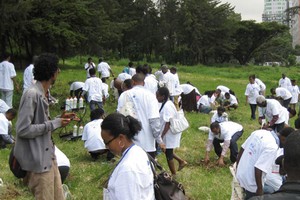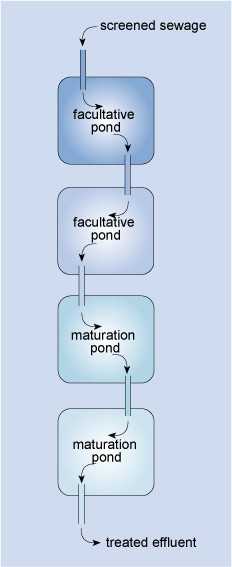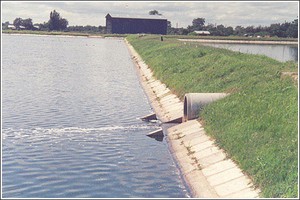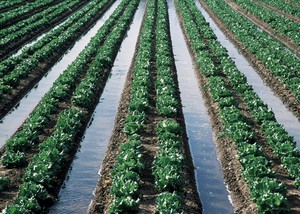Treating sewage for reuse
A lot of water is used for purposes where high-quality drinking water is not necessary.
Can you think of water uses where the quality does not have to be of drinking water standard?
You may have thought of the washing of outdoor areas (like the house yard), washing of vehicles and gardening, but you could have mentioned anything that does not involve ingestion of the water.
One of the biggest uses of water is in irrigation, not only for food crops but also for landscaping schemes in cities like Addis Ababa (Figure 11.6). For uses such as these, it is possible to use treated sewage effluent to water plants, if this is available. Sewage treatment can be an economical process using a simple system of ponds called waste stabilisation ponds, which are described below. (Note that reuse of the water is only feasible for fully treated sewage; septic tank discharge should not be used in this way.) In Ethiopia the opportunities for reusing treated sewage effluent may be limited at the moment, but future changes could see more sewage treatment systems, which would increase the potential.

Figure 11.6 Volunteers planting trees in Addis Ababa, on World Environment Day, 5 June 2013.
Waste stabilisation ponds
Waste stabilisation ponds are natural or constructed ponds used for treating sewage or other wastewaters biologically by harnessing the power of sunlight and wind. They are therefore ideal for tropical countries, and in Ethiopia there is such a system at Kality, treating the sewage from Addis Ababa.
In a typical waste stabilisation pond system, effluent that has passed through a screen is sent through a series of ponds with a total retention time of 10–50 days. (The retention time, in this context, is the length of time the effluent stays in the ponds.) No mechanical equipment is used in the ponds, so operation and maintenance costs are very low. Figure 11.7 shows a typical layout for a waste stabilisation pond system treating domestic sewage.

Figure 11.7 Layout of a waste stabilisation pond system for treating domestic wastewater.
Bacteria in the ponds oxidise the pollutants and work symbiotically with algae, which provide oxygen through photosynthesis. (A symbiotic relationship means two types of living organisms live together for their mutual benefit. In this case, the algae produce the oxygen that the bacteria need, and the bacteria produce carbon dioxide and release ammonia and phosphate that the algae consume.)
Oxygenation also occurs through the action of wind, and by diffusion. Diffusion is the movement of a substance from a region of high concentration to one of low concentration. In the present context it means the movement of oxygen from the air, where it makes up 21% of the composition, to the water, where it is in low concentration.)
The major part of the biodegradation of the sewage (the breaking down of complex substances in sewage into simpler compounds, by micro-organisms) takes place in the facultative ponds (Figure 11.7). These are ponds in which the upper portion is aerobic and the lower portion is anaerobic. Facultative ponds are 1–1.5 m deep, with a retention time of 5 to 30 days. Solids settle to the bottom and are anaerobically digested by bacteria, so that sludge removal is rarely needed.
Maturation ponds are ponds placed after facultative ponds, for the purpose of pathogen reduction. They are usually 0.5–1.5 m deep, with a retention time of 15 to 20 days. The ponds serve to inactivate pathogenic bacteria and viruses through the action of UV radiation from sunlight and by the greater algal activity in these shallow ponds, which raises the pH to above 8.5 (when pathogens are rapidly killed off). The long retention time in each of the ponds also enhances the sedimentation of eggs of intestinal nematodes (parasitic worms).
To prevent sewage from leaching away, and to preserve the effluent for reuse later, the ponds should have a liner. This can be made of clay, asphalt, compacted earth, or any other impervious material (material that does not let anything through). To prevent run-off from entering the ponds, and to prevent erosion, a protective, raised earth barrier can be constructed around the ponds using the excavated material from their construction. A fence is needed to keep people and animals out (Tilley et al., 2014).
Any scum that builds up on the surface of the facultative and maturation ponds should be removed to allow sunlight to reach all the algae, and also to increase surface aeration. Large plants that are present in the water should be removed.
A further benefit of waste stabilisation ponds is that at the same time as treating wastewater, they can be used to increase protein production through the rearing of fish (such as Tilapia) and ducks in the maturation ponds.
Figure 11.8 shows part of waste stabilisation pond system.

Figure 11.8 Part of a waste stabilisation pond system in Tanzania.
Waste stabilisation ponds are especially efficient in hot climates. Although they require large areas of land, this need can be satisfied by locating the ponds at the outer perimeter of cities or on disused land. At the Kality waste stabilisation ponds on the outskirts of Addis Ababa, the system consists of one facultative pond and three maturation ponds, with a total retention time of 28 days. In an evaluation of Addis Ababa’s sewage treatment system in 2010, Dagne found that an average of 83.6% of the organic pollutants was removed by the process.
Health protection measures
The critical parameter for assessing the suitability of using the effluent from waste stabilisation ponds for irrigation is microbiological analysis for the presence of pathogens. Treated effluent can be reused in crop irrigation if safe limits of faecal coliforms and intestinal parasites are achieved in the treatment process. The World Health Organization (2006) addresses this in Wastewater Use in Agriculture, Volume 2 of its Guidelines for the Safe Use of Wastewater, Excreta and Greywater. An important consideration is the type of crop that is being grown. If it meets specified standards, wastewater can be used to irrigate crops that are not eaten raw. This is called ‘restricted irrigation’ and includes non-food crops (such as cotton or oilseed), food crops that are processed before consumption (such as coffee or wheat), and crops that have to be cooked (such as rice or potatoes). For this type of crop, the WHO has specified that the level of faecal coliforms should not exceed 105 per 100 ml of treated effluent, and there should be no more than one intestinal nematode egg in 1 litre of treated effluent (WHO, 2006). (If children under the age of 15 are exposed to the treated effluent, for example by working or playing in fields irrigated with treated effluent, the limit for intestinal nematode eggs becomes stricter at one egg per 10 litres of treated effluent).
Another important consideration is the type of irrigation. If spray irrigation is used, there should be a buffer zone of 50–100 m between the irrigated fields and any nearby houses and roads, so that local people are not affected by airborne wastewater. In Ethiopia, flood irrigation or furrow irrigation is common; this is where farmers flow water down small trenches running through their crops (Figure 11.9). In this situation, the possibility of human contact with treated effluent is high.

Figure 11.9 Furrow irrigation, where there is a high chance of farmers coming into contact with the water used.
In all situations, anyone who comes into contact with untreated or treated effluent should wear appropriate protective clothing, including gloves and boots. After working at the ponds, or after working on the irrigation of crops, people should wash themselves thoroughly. While the ponds may be designed for the production of water safe for irrigation, it is best to be safe and avoid all direct contact with the effluent.